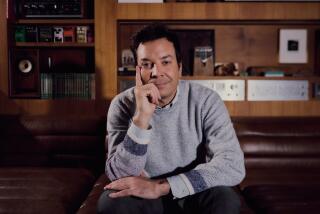If you’re not paying attention to late-night TV right now, you should
Back in the 10th grade, my biology class was assigned to crossbreed fruit flies. The point was to teach us about genetics, an experiment made possible by their accelerated life cycle. They run through generations like I run through synonyms for “pandemic.” The main lesson, for me anyway, was that it is not hard to fake a lab book. Perhaps that is why I am a writer.
Something similar is happening in late-night television, which also comprises a kind of laboratory where things move fast. In two or three weeks a late-night show produces as many episodes as other television series, scripted or unscripted, make in a year, airing nearly in real time, offering nightly opportunities to fiddle and fix, and fiddle and fix some more.
In late March, as late-night television moved home with the hosts after briefly taping in empty studios, I wrote about how the form was going forward by borrowing language from the internet, where working from home is a well understood practice. One gets the sense from those first tentative, partial episodes that no one involved expected this decampment to be more than brief. Hosts broadcast from different rooms of their house, as if by the time they had run through them all, it would be safe to return to the studio. Perhaps settling in one place for two nights running might have seemed like an admission that “normal” was a long way off.
Two months later, having passed through the hastily improvised “Our Gang” phase, these shows have achieved a new normal: a consistent, thought-through approach to making full-service late-night television remotely, spouses running cameras and children running through a shot. They have evolved, adapted to their altered environment, with new openings and fresh graphics (some by the host’s children), improved lighting and sound, and expanded titles: “The Tonight Show at Home Edition,” “Jimmy Kimmel Live (From His House),” “The Daily Social Distancing Show.” Stephen Colbert adds an indefinite article to make “A Late Show with Stephen Colbert” (alternately titled “A Late Show with Stephen at Home”) — that is, a version of the thing, but not exactly the thing. Hosts have settled in place, most angled into a corner, imparting a sense of depth and stability. They have their desks, their tchotchkes.
What is it like for homebound writers and host to make late-night comedy in the time of coronavirus? ‘Not normal,’ says Seth Meyers.
The relatively limited vocabulary of lockdown-era TV has proved more flexible and individual than one might have expected. Even before self-isolation, most late-night shows were cut to a similar pattern: monologue, skits (sometimes cut into the monologue), interview(s), with a musical performance often tacked on at the end. Yet each has distinct personality, a position, a plan. We follow the hosts that make sense to us, much as an ancient Greek might have followed Socrates or Pythagoras. Of course, it’s possible to watch them all, posted in their constituent parts on the internet, according to one’s mood, needs and sense of humor; lately, I watch them all.
Like pretty much everything in the world these days, the goal is to create something that feels at least a little like life in The Before, something that satisfies old expectations while acknowledging the fact that things are different now. More than the government they mockingly hold to account, these shows beg you to recognize the pandemic for what it is: dangerous and not nearly over. And every late-night show has managed to construct a creditable version of its older self with available materials. It may be more difficult and less fun for the hosts — when every day is Bring Your Kids to Work Day (and in some cases Put Your Kids to Work Day), I can see that it might get a little wearing. And, of course, we never put as much faith in the approval of our own household as in the applause of strangers.
Well, here’s an applauding stranger.
With the host and the guest essentially alone together — Face Time to Face Time is a joke I might have made before — the performance of intimacy that talk shows typically offer grows closer to real intimacy. Interviews become conversations, even though they may still may be keyed, as in the olden days, to promoting a book or TV show or film. And because host and guest are looking into a camera, we’re placed into the middle of their virtual shared space, rather than looking on from afar as a member of an audience.
In addition, there’s the fact that we are inside their homes, or in Samantha Bee’s case, on some woodsy part of her property. “Welcome to the longest and worst episode of MTV’s ‘Cribs’ ever,” said Jimmy Kimmel recently. “There’s nothing fun to see in this house, including the owner.” James Corden, John Oliver and Bee still dress up for work, but Colbert has ditched his suit for shirtsleeves. Guests are often dressed way down, as if they’re flying coach, but the fact is that famous people tend to look pretty good even without the attention of styling professionals. And when they don’t, it’s impressive in its own way: Celebrities, only human, so cool!
We see their wives, their kids. Bee’s husband and photographer Jason Jones stays hidden; and John Oliver is doing “Last Week Tonight” just as before, sans audience and without a cityscape backdrop.) Alone among the at-home hosts, Trevor Noah seems to be living the single life — I don’t know his relationship status — in his minimalist apartment, with jokes that speak to the difficulties of being really alone. A daily schedule is helpful, he mused not long ago, “that’s why every day I get up at 3 in the afternoon, shower and then immediately take a nap — it keeps me going.” Other advice: “Any bread can be tortilla if you just use a hammer.” “Take some of your nail clippings, soak them in water, and in a few days they’ll grow into a clone of you.”
From Joe Biden’s video dispatches to at-home news anchors, TV’s post-COVID future is already here.
Where some hosts get by with a little detail — a desk, a wall-mounted monitor displaying the name of the show — Seth Meyers has gotten a lot of mileage out of a copy of “The Thorn Birds” placed on a table behind him. Corden has transformed a corner of his garage into an actual set, theatrically lighted, to recreate as much as possible the vibe of his party-time “Late Late Show.” One camera angle puts Corden and his guests within a single shot, sharing space, as we look over Corden’s shoulder toward a laptop screen. (It sits to his left, where guests were wont to do.) Another screen, to his right, features sidekick-bandleader Reggie Watts and the studio band. There are relatively elaborate bits and skits: “Normal People” stars Daisy Edgar-Jones and Paul Mescal putting a romantic spin on dialogue lifted from the Home Shopping Network and “Kitchen Nightmares.” Corden discovering on a Zoom call that his staffers have been having game night without him. Corden dealing with an offscreen neighbor who doesn’t seem to understand a show is underway: “How do you film it exactly?” “It’s all done on Zoom.” “I don’t know what Zoom is — is Zoom like Quibi?”
If Corden is giving us as much of the normal show as he can manage, Jimmy Fallon — whose playhouse of a house (there is a slide to get downstairs) was a set in waiting — is hitting some interesting new notes. Although he remains very much a human golden retriever, he has deepened with this context: He seems more adult, even healthier, than his soundstage self, more relaxed. In a recent segment of “Ask the Fallons,” he and his wife went for “a safe walk” in their neighborhood and talked about their struggle to have kids. (Their struggle with their kids, two little girls, is also there for you to see.) At the same time, the show is finding its group spirit under lockdown. A performance by Brendon Urie, Fallon and the Roots of the David Bowie-Queen collaboration “Under Pressure” with “at-home instruments” was as joyous a few minutes as you’ll see in a month of television.
It may just be that I find these shows more than usually necessary for my well being, the times being what they are — they process the day, much as our own brain is said to do in sleep — but I am enjoying them mightily. I wouldn’t suggest for a second that a deadly pandemic is worth it, but if we have to have one, I’m glad these shows are keeping us company. Stephen, Jimmy, Jimmy, Samantha, Noah, Conan, Seth, John and James — thank you. You are doing essential work, and I do not need a studio audience to tell me when to laugh.
More to Read
The complete guide to home viewing
Get Screen Gab for everything about the TV shows and streaming movies everyone’s talking about.
You may occasionally receive promotional content from the Los Angeles Times.








